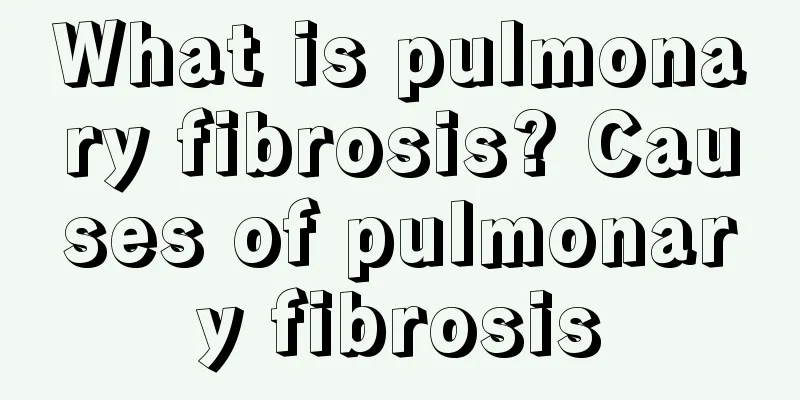What is pulmonary fibrosis? Causes of pulmonary fibrosis

|
The main symptom of pulmonary fibrosis is dyspnea, which will be more obvious after fatigue. Dry cough will also occur in the later stage. If not treated in time, it will cause secondary infection, and in severe cases it will cause respiratory failure. It is necessary to check and confirm the diagnosis in time and give appropriate treatment. 1. What is pulmonary fibrosis? 1. Main symptoms (1) Dyspnea: Dyspnea is caused by exertion and is progressively worse. The patient has shallow and rapid breathing. Nasal wing movement and accessory muscles may be involved in breathing, but most patients do not sit up and breathe. (2) Cough and sputum: There is no cough in the early stage, but there may be a dry cough or a small amount of mucus sputum later, which is prone to secondary infection. Mucopurulent or purulent sputum, occasionally bloody sputum, is present. (3) Systemic symptoms may include weight loss, fatigue, loss of appetite, joint pain, etc., which are generally rare. Acute cases may be accompanied by fever. 2. Common signs (1) Dyspnea and cyanosis. (2) Chest expansion and decreased diaphragm activity. (3) Velcro-Up sound in the middle and lower parts of both lungs, which is characteristic. (4) Clubbing of fingers and toes. (5) Corresponding signs of end-stage respiratory failure and right heart failure. 2. Inspection 1. Imaging examination (1) Conventional chest X-ray filming techniques require proper penetration conditions, the use of moderately intensifying screens, and a small focus. In the early stage of alveolitis, no abnormalities can be shown on X-rays; as the disease progresses, X-rays show diffuse shadows with cloudy and faint tiny dots, like ground glass. As the disease progresses, fibrosis becomes more obvious, from fine reticular to coarse reticular, or reticular nodular. In the late stage, there are cystic changes of varying sizes, which is called honeycomb lung. The lung volume decreases, the diaphragm rises, and the interlobar fissures shift. (2) CT contrast resolution is superior to that of X-rays. The use of high-resolution CT (HRCT) can further improve spatial resolution, which is extremely helpful for the diagnosis of IPF, especially for the differentiation of early alveolitis and fibrosis and the detection of honeycomb lung. (3) Radionuclide IPF often has increased alveolar capillary membrane permeability. The measurement of pulmonary epithelial permeability (LEP) by inhalation of 99mTc-DTPA aerosol using radionuclide technology can show a shortened T1/2, which is helpful for the early detection and diagnosis of interstitial lung disease, but is not specific for IPF. 2. Pulmonary function test Typical changes in lung function in IPF include restrictive ventilation impairment, reduced lung volumes, decreased lung compliance, and decreased diffusion capacity. In severe cases, PaO2 decreases and PA-aO2 widens. Pulmonary function tests and imaging techniques can help with early diagnosis, especially exercise testing, which can reveal decreased diffusion capacity and hypoxemia before imaging abnormalities appear. Pulmonary function tests can be used for dynamic observation, which is very helpful for disease assessment and may also be useful for evaluating the efficacy of treatment. Similarly, pulmonary function abnormalities in IPF are nonspecific and have no differential diagnostic value. 3. Bronchoalveolar lavage An increase in the total number of cells in bronchoalveolar lavage fluid and an increase in the proportion of neutrophils are typical changes in IPF and are helpful for diagnosis. It is still mainly used for research. 4. Lung biopsy The histological changes in the early and middle stages of IPF have certain characteristics, and the causes of interstitial lung disease include many with clear causes. Therefore, lung biopsy is very meaningful for the diagnosis and activity evaluation of this disease. Fiberoptic bronchoscopy is the first choice for TBLB, but the specimen is small and diagnosis is sometimes difficult. Thoracoscopic or open lung biopsy should be performed when necessary. |
<<: What medicine is effective for cor pulmonale? Common Chinese medicine prescriptions
>>: How to maintain pulmonary fibrosis, pay attention to care to be healthier
Recommend
Rectal neuroendocrine tumors need to be treated like this
Neuroendocrine tumors are tumors that originate f...
What are the benefits of soaking your feet at night
Foot soaking has many benefits. For people with c...
Early detection and treatment of HPV infection is the prevention of cervical cancer
At present, it has been clinically confirmed that...
What is the reason for the spots on the lungs
As daily living standards continue to improve, ev...
Listen to your body and learn that the five internal organs have very different methods of detoxification
The fast pace of life and irregular diet have cau...
What to do if you have less hair and poor hair quality
Some people have very good hair, and any hairstyl...
How to wash oil stains on down jackets
For those of you who often wear down jackets, you...
Can cholestasis be cured
Cholestasis has a great impact on people's he...
How long does it take for lung cancer to cause weight loss
Lung cancer may cause weight loss symptoms in abo...
What is the reason for stomachache when getting up in the morning
Stomach pain may actually be caused by a variety ...
Can expired blush be used?
There are many types of cosmetics, and generally ...
Can patients with lung cancer eat barley, red bean and lotus seed porridge?
Can patients with lung cancer eat barley, red bea...
Will drinking fresh milk before going to bed make you fat?
Nowadays, milk is becoming more and more popular ...
What is the TG value after unilateral resection of thyroid cancer
Thyroid cancer is a malignant tumor that originat...
What should I do if I have an itchy scalp, dandruff, and hair loss?
Now that the weather is getting hotter and hotter...









